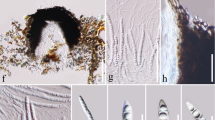Summary
We propose and diagnose a new species of Ocotea (Lauraceae), O. mellosilvae. On the basis of morphological evidence, the species seems to be a member of the Ocotea notata group. We also present its morphological description, illustrations, distribution, habitat, phenology, and etymology.




Similar content being viewed by others
References
Bachman, S., Moat, J., Hill, A. W., de la Torre, J. & Scott, B. (2011). Supporting Red List threat assessments with GeoCAT: geospatial conservation assessment tool. ZooKeys 150: 117 – 126.
Baitello, J. B. & Marcovino, J. R. (2003). Lauraceae: Ocotea Aubl. In: M. G. L. Wanderley, G. J. Shepherd, A. M. Giulietti & T. S. Mehem (eds), Flora fanerogâmica do Estado de São Paulo. Pp. 179 – 208. FAPESP, RiMa, São Paulo.
Chanderbali, A., van der Werff, H. & Renner, S. S. (2001). Phylogeny and historical biogeography of Lauraceae: evidence from the chloroplast and nuclear genomes. Ann. Missouri Bot. Gard. 88: 104 – 134.
de Queiroz, K. (2007). Species concept and species delimitation. Syst. Biol. 56: 879 – 886.
Fiaschi, P. & Pirani, J. R. (2009). Review of plant biogeographic studies in Brazil. J. Syst. Evol. 47: 477 – 496.
Giulietti, A. M., Pirani, J. R. & Harley, R. M. (1997). Espinhaço Range Region, Eastern Brazil. In: S. D. Davis, V. H. Heywood, O. Herrera-Macbryde, J. Villa-Lobos & A. C. Hamilton (eds), Centres of plant diversity – a guide and strategy for their conservation, pp. 397 – 404. The Americas. WWW/IUCN, Cambridge.
IUCN (2012). IUCN Red List Categories and Criteria, Version 3.1. Second edition. IUCN, Gland & Cambridge.
IUCN Standards and Petitions Subcommittee (2017). Guidelines for Using the IUCN Red List Categories and Criteria, Version 13. Prepared by the IUCN Species Survival Commission. IUCN Council, Gland & Cambridge. http://www.iucnredlist.org/documents/RedListGuidelines.pdf. Accessed 5 August 2020
Mez, C. (1889). Lauraceae americanae. Jahrb. Königl. Bot. Gart. Berlin 5: 1 – 556.
Quinet, A., Baitello, J. B., Moraes, P. L. R., Assis, L. C. S. & Alves, F. M. (2015). Lauraceae. In: BFG - Brazilian Flora Group. Lista de Espécies da Flora do Brasil. Growing knowledge: an overview of seed plant diversity in Brazil, pp. 1085 – 1113. Jardim Botânico do Rio de Janeiro.
Radford, A. E., Dickson, W. C., Massey, J. R. & Bell, C. R. (1974). Vascular plant systematics. Harper & Row Publishers, New York.
Rapini, A., Ribeiro, P. L., Lambert, S. & Pirani, J. R. (2008). A flora dos campos rupestres na Cadeia do Espinhaço. Megadiversidade 4: 15 – 23.
Rohwer, J. G. (1986). Prodromus einer Monographie der Gattung Ocotea Aubl. (Lauraceae), sensu lato. Mitt. Inst. Allg. Bot. Hamburg 20: 1 – 278.
Rohwer, J. G. (1993). Lauraceae. In: K. Kubitzki, J. G. Rohwer & V. Bittrich (eds), The families and genera of vascular plants, pp. 366 – 391. Springer-Verlag, Berlin.
Thiers, B. (2020). Index herbariorum. Part I: The herbaria of the world. New York Botanical Garden, New York. Available at <http://sweetgum.nybg.org/ih/>. Accessed 6 April 2020.
van der Werff, H. (1991). A key to the genera of Lauraceae in the New World. Ann. Missouri Bot. Gard. 78: 377 – 387.
van der Werff, H. (2017). Studies in Andean Ocotea (Lauraceae) IV. Species with unisexual flowers and densely pubescent leaves, or with erect pubescence or domatia, occurring above 1000 m in altitude. Novon 25: 343 – 393.
Weberling, F. (1992) Morphology of flowers and inflorescences. Cambridge University Press, Cambridge.
Acknowledgements
This study is part of the master’s thesis of C.C.A.S. developed at PPG Biologia Vegetal - UFMG, Brazil with a scholarship from Coordenação de Aperfeiçoamento de Pessoal de
Nível Superior (CAPES) grant number 88882.184411/2018-01. We thank CAPES for the scholarship provided. Furthermore, we would like to thank two anonymous reviewers for their contribution to improve this article, with relevant comments and observations. Finally, we would like to thank the Instituto Estadual de Florestas - IEF, especially Hugo Guimarães, who received us at the Parque Estadual da Serra do Cabral, and with his team made it possible to collect the specimens.
Author information
Authors and Affiliations
Corresponding author
Additional information
Publisher’s Note
Springer Nature remains neutral with regard to jurisdictional claims in published maps and institutional affiliations.
Rights and permissions
About this article
Cite this article
Assunção-Silva, C.C., Magalhães, R.A. & Assis, L.C.S. Ocotea mellosilvae (Lauraceae): a new species from the Espinhaço Range, Brazil. Kew Bull 75, 48 (2020). https://doi.org/10.1007/s12225-020-09914-3
Accepted:
Published:
DOI: https://doi.org/10.1007/s12225-020-09914-3




